 |
| October 11, 2016 | Volume 12 Issue 38 |
Designfax weekly eMagazine
Archives
Partners
Manufacturing Center
Product Spotlight
Modern Applications News
Metalworking Ideas For
Today's Job Shops
Tooling and Production
Strategies for large
metalworking plants
Wheels:
Modified Chevy pickup, complete with fuel-cell system, is ready for extreme military field testing
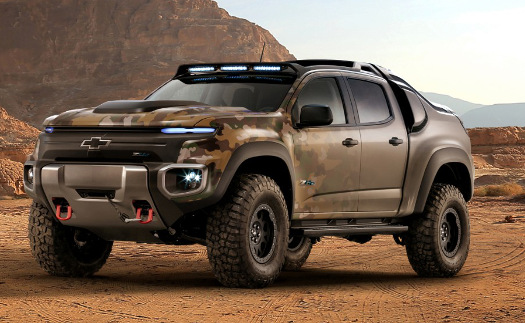
[All images courtesy GM, except where noted]
The almost video-game-like Chevrolet Colorado ZH2, the most extreme off-road-capable fuel-cell-powered electric vehicle ever from General Motors, was revealed Oct. 3 at the 2016 Annual Meeting and Exposition of the Association of the United States Army (AUSA) in Washington, D.C.
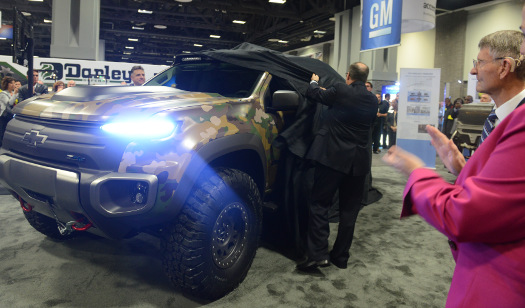
The ZH2 hydrogen fuel-cell electric vehicle is unveiled at AUSA 2016. [Photo Credit: David Vergun, U.S. Army]
Standing more than 6.5 ft tall and more than 7 ft wide, and built on a stretched midsize pickup chassis, the hydrogen-powered Colorado really has gone commando. Reinforced inside and out, the ZH2 rides on 37-in. tires and a specially modified suspension that helps the vehicle climb over and descend all manner of terrain.
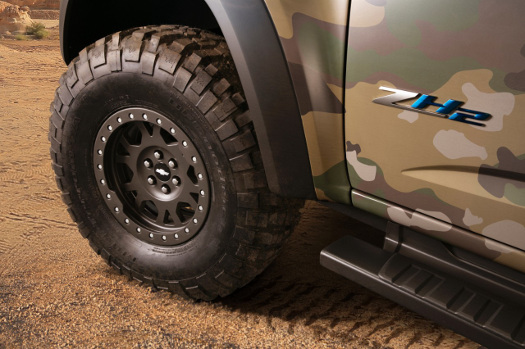
The U.S. Army will test the Colorado ZH2 in extreme field conditions next year to determine the viability of and capabilities that a fuel-cell electric powertrain can bring to the military, including quieter mobility, exportable power generation, low-end torque, and water generation.
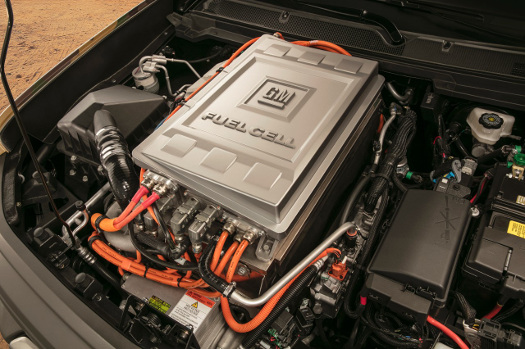
The fuel-cell system under the power dome hood of the Chevy Colorado ZH2 has accumulated 3.1 million miles of real-world driving by civilian and military operators and is ready for a year of extreme off-road testing as a U.S. Army demonstrator.
Alan Adler, Global Advanced Technology Communications, General Motors, told Designfax: "The ZH2 holds 4.2 kg of gaseous hydrogen in three onboard tanks. The hydrogen is converted to electricity onboard. Because of the low-end torque capability across the range, the ZH2 will travel about 140 miles on a hydrogen fill-up (10,000 psi/700 bar)."
The Army demonstrator Colorado ZH2 features an Exportable Power Take-Off unit (EPTO) that allows the fuel cell to power activity away from the vehicle, such as remote locations where electric power may otherwise be unavailable.
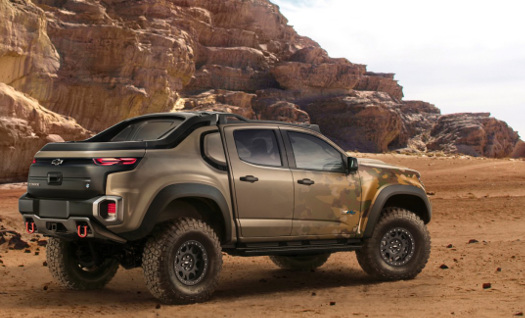
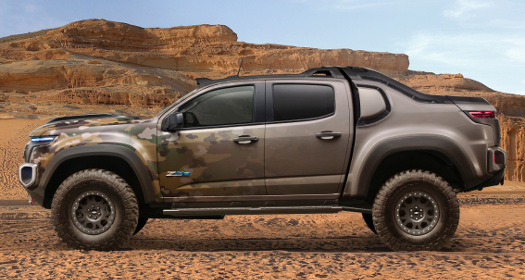
GM and the U.S. Army Tank Automotive Research, Development and Engineering Center (TARDEC) collaborated to develop the Colorado ZH2 from contract to concept in less than a year.
"Fuel cells have the potential to expand the capabilities of Army vehicles significantly through quiet operation, exportable power, and solid torque performance, all advances that drove us to investigate this technology further," said Paul Rogers, director of TARDEC.
The Army will evaluate the ZH2 fuel cell for:
- Near-silent operation enabling silent watch capability;
- Reduced acoustic and thermal signatures;
- High wheel torque at all speeds via electric drive;
- Low fuel consumption across operating range; and
- Water by-product for field uses.
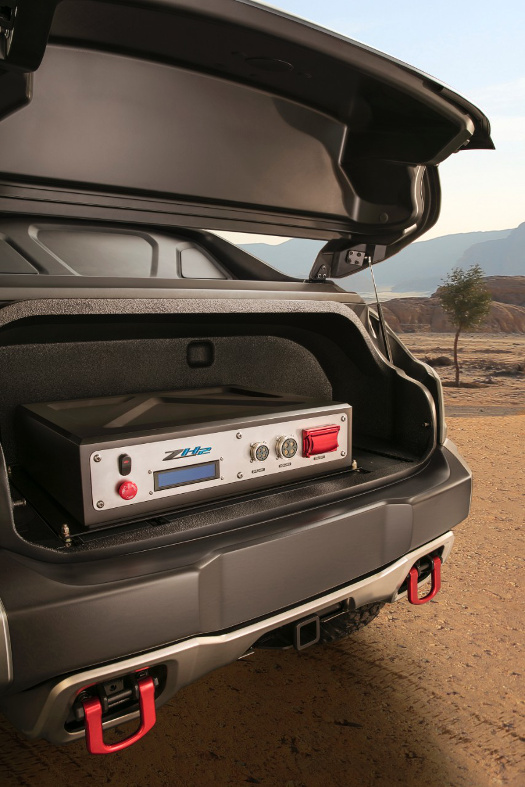
Inside the rear hatch of the Chevrolet Colorado ZH2 is an Electric Power Takeoff unit capable of providing 25 kW of consistent electric power away from the vehicle, such as remote locations where electric power may not be available.
Kevin Centeck, team leader for Non-Primary Power Systems, Ground Vehicle Power and Mobility Directorate, TARDEC, said that this -- and future vehicles like it -- have many advantages for Soldiers in combat.
First, the ZH2 operates on hydrogen fuel instead of traditional diesel. It uses a lot less fuel than traditional tactical vehicles, he said. At idle, it is "extremely efficient." This should reduce the logistics train.
Second, since the vehicle uses hydrogen with electric power, it has "an extremely low acoustic signature," Centeck said, meaning it's very quiet. "It's silent mobility, silent watch," he added. "You don't give away your position by turning on the engine" or hearing the diesel engine while driving.
Third, the ZH2 has a radically reduced thermal signature because it doesn't operate as hot as a diesel engine. This gives additional stealth for Soldiers, since the heat signature is harder to pick up by enemy thermal sensors, he said.
A fourth, less-direct, but nonetheless important advantage, Centeck said, is the Army wanted to demonstrate that a vehicle of this type could be built rapidly using mostly off-the-shelf parts. This took just one year from concept to delivery. The vehicle itself is basically a Chevy Colorado platform.
Centeck called the development of the vehicle a "collaborative effort" between TARDEC and GM, with collaboration on evaluations and fuel-stack testing.
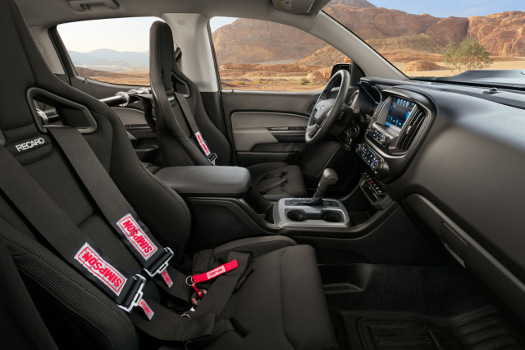
We doubt that the 2+2 interior of a final military production vehicle, if there ever is one, will feature benefits like Recaro seats, but they sure look sweet on the prototype.
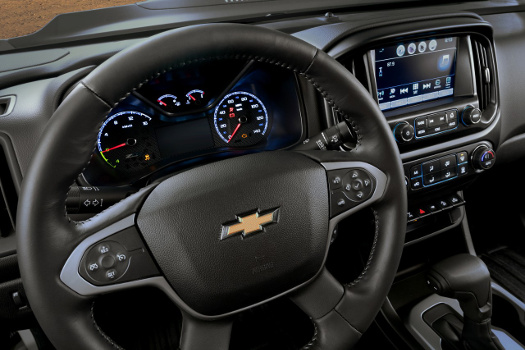
GM and TARDEC have fuel-cell development laboratories located 20 miles apart in southeast Michigan. Most of the Colorado ZH2 was assembled in GM's Advanced Vehicle Integration facility in Warren. Calibration testing at GM's Milford Proving Ground will continue into early 2017, when the vehicle will be turned over to the Army for a year of field testing.
"Over the next year, we expect to learn from the Army the limits of what a fuel-cell propulsion system can do when really put to the test," said Charlie Freese, executive director of GM Global Fuel Cell Activities.
VIDEO: Time-lapse sequence of Chevrolet Colorado ZH2 assembly.
Delivery of the ZH2 from GM to the Army will take place April 1, 2017. Centeck said.
Following delivery, user evaluations will take place with Soldiers at Fort Benning, GA; Fort Bragg, NC; and, Fort Carson, CO. Those evaluations will take place over the course of a year.
The user evaluation process will be rigorous, Centeck said. It will include subjective feedback from Soldiers as well as objective feedback in order to get a full data set. Over the course of the next few years, the Army will look to see how it can best support hydrogen supply in the field, he said. Department of Energy tacticians and logisticians will help conceptualize this and help provide a plan.
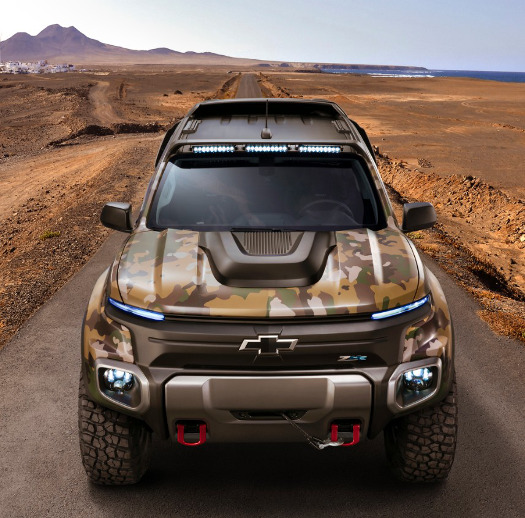
The Colorado ZH2 contract is GM's second vehicle development with a U.S military branch announced this year. In June, the U.S. Navy unveiled a GM fuel cell-powered Unmanned Undersea Vehicle (UUV) that is currently in pool testing before eventual deployment. The UUV leverages GM fuel-cell technology common with the Colorado ZH2, demonstrating the flexibility to power a range of mobile and stationary devices.
"Hydrogen is very common and can be taken from many sources, including renewables," said GM's Adler. "GM has more than 3.1 million miles of real-world driving through our Project Driveway program in which a fleet of 119 Chevrolet Equinox FCEVs were driven for several weeks at a time by more than 5,000 people. The system in the ZH2 is the same as the Equinox. The next-generation system will be dramatically smaller, lighter, and use far less platinum as a catalyst. A range of 300 to 400 miles is well within reach."
Sources: Compiled from reports by General Motors, U.S. Army ("Army, GM unveil new tactical hydrogen vehicle" by David Vergun, 10/6/2017), Designfax reporting
Published October 2016
Rate this article
View our terms of use and privacy policy
